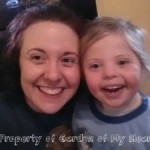Disability World is full of transitions. Most of them are somewhat artificial – they are driven by funding streams and federal laws rather than a specific need. Rowenna is quickly approaching one of these transitions. Right now she is in the Birth to Three program. This is exactly what it sounds like – she started nearly at birth and will officially transition on her third birthday. This program is our current connection to the vast service system in place for people with disabilities. Our case coordinator helped facilitate our application for our Medicaid waiver, our application to a separate funding stream (we are about two years into a five year wait) that will help us pay for services not covered by insurance or Medicaid, and provides us with information about other state and county programs available to us. They also provide Rowenna’s in-home therapy.
So now it’s time to begin the transition to public school. In Disability World, the funding stream makes an abrupt shift on the third birthday from Birth to Three (or similar program) to the local public school district. And by abrupt I mean if Rowenna’s birthday is on a Tuesday, Birth to Three will provide her therapy on Monday of that week and the school district will be responsible for her therapy on Tuesday. No gentle transition to soften the blow, to help a child get to know a new team of teachers and therapists, or for parents to take in this new stage of life.
Before we make that transition, Rowenna will undergo a series of evaluations to make sure she is disabled “enough” to qualify for special education services and therapies. These evaluations will also be used to decide what level of services she can receive in the coming school year. (Since Rowenna’s birthday falls in the last week of school, we are opting to not place her in school this year and wait for the beginning of the new school year.) After the evaluations, we will sit down with a team from the local public school and write out an Individualized Education Plan (IEP). This will be the guiding document for Rowenna’s first year of public school, should we decide to send her in the fall.
Going into this meeting, I’d heard absolute horror stories about how these have gone for other families. The kind of stories that make you wonder why certain people choose education versus, well, any other career on the face of the earth. I’d also heard some success stories, and I hoped I could count myself among that group before this whole process was done. I tried to strike a balance between gearing up for a bit of a battle and going in with an open mind.
In my county, the first of these many meetings happen in the child’s primary residence. They want to meet your child in an environment that is safe and natural to the child. In my opinion, this is a good first start. It shows an understanding of children at this age, and an understanding of the obstacles some families face in simply leaving their homes (medical equipment, health concerns, transportation, etc).
As is the way of toddlers, Rowenna had an epic meltdown just before the meeting started, so she was not her perky, sparkly self that I know and love. She had pulled it together enough to no longer be howling, but she was a bit sullen and had no smiles for the teacher. I had my list of questions and my favorite pen, ready to take lots of notes so I could remember what we discussed and share with hubby later on.
We spoke about our options for the coming year. We can enroll her for 1-4 days a week, or not at all. We can choose to bring her to school just to receive therapy. We can choose to discontinue therapy. We can have her ride a bus to school both ways, one way, or not at all. She can attend in the afternoon or the morning. So, lots of choices to consider and I am grateful for so many options. To me it represents an attitude of doing what works for the child and the family, rather than what works best for the school.
Then I started asking harder questions and found the answers to be a bit lackluster, though I get the distinct impression that she is rarely asked questions like this so she didn’t seem prepared. I asked why kids with disabilities go to school at the age of three when their typically developing peers stay at home or attend preschool or daycare. The answer boiled down to “social skills and structure.” (From a purely funding/policy standpoint, the answer is: the money needs to funnel somewhere and schools are an obvious and easy choice.)
Ok, fair enough. Not every family works with a structure, and not every family has a lot of social opportunities for their kiddo.
But to me it’s not an overwhelmingly good reason to just go with the flow and put her in school because she’s three and it’s what you do. (Which, by the way, is clearly the choice the school is looking for us to make.)
I asked about what inclusion looks like in our district, and how well supported that inclusion is. I taught – albeit briefly – in this district and my experience was less than stellar. Where special education, support for my students, and support for IEPs was concerned, it was an absolute failure. So I admit to going into this with a bit of a tainted opinion, but there is no way on earth I’m going to allow my child to be in an “inclusive” classroom if it means she’s left there with zero supports and a special education teacher with such a large caseload there are simply not enough hours in the days to support Rowenna. Inclusion is only inclusion if she’s set up for success. Allowing for only the physical presence of kids with disabilities is not inclusion, it’s more like…sight-seeing. Or a museum. Look, but don’t touch.
I was told that inclusion is always the goal, and it’s the “default” for kids receiving special education services. Segregation and self-contained classrooms are available for those students who truly benefit from that environment. She wouldn’t speak to the availability of aides, therapists, special education teachers, or resources because that would be too specific without knowing what Rowenna will need in three years.
Again, fair enough. (Though I still have my doubts about what inclusion actually looks like, given what I know about budget cuts in our district.) To me, it is important that the spirit is willing and the philosophy of inclusion is already in place. We aren’t starting from square one here.
I asked what an IEP typically looks like at this age. It usually involves some social/peer interaction goals, fine motor goals, and speech goals. Gross motor goals if applicable, but likely not for Rowenna at this time.
And again, this all seemed fair and reasonable.
I do have a few concerns. The classroom is full of adults who are constantly interacting with the students (by the teacher’s own description). Between the teachers, aides, and therapists, it is nearly a 1:1 ratio. That honestly seems excessive. In her explanation of the schedule, there did not seem to be much room for independent exploration. Even during “free play,” adults are constantly intervening with the children to make sure they are “working on skills.” This is not what happens in the Montessori environment in which Rowenna currently thrives. There are adults, yes, and they work with the students. But it is not a 1:1 ratio, and they are allowed personal space to simply try things without intervention. Hubby and I believe that this is an essential, core skill for Rowenna – to feel safe to try new things and have the curiosity to do so independently – so it is of some concern that this doesn’t seem to be promoted in her potential future classroom.
I also have a lingering concern about being constantly surrounded by “disability professionals” rather than two teachers who specialize in general child development. In other words, do we want her surrounded by people “treating” Down syndrome and constantly intervening, or do we want her in an environment where she is free to make mistakes and try new materials? Only time will tell what level of support Rowenna will benefit from this fall.
So going forward, it seems we are left with more questions than answers and so much to consider. I am glad that there weren’t any alarm bells going off during this meeting, no obvious reasons to say “oh heck no” to public school. I am glad that when we make our decision for Rowenna, it will be based on what she needs and where she will thrive, not on a disagreement over policy or a clash with a teacher.
Our options for the fall are thus (based on Rowenna receiving a scholarship to continue at Montessori): only Montessori school, only public school, a combination of both, just therapy, or absolutely nothing at all.
Our lingering questions:
- Where will Rowenna be best supported in her personal development?
- Where will Rowenna be treated as an individual?
- Where will Rowenna thrive?
We don’t have the answers to these questions yet. We have some ideas, and today’s meeting certainly gave us food for thought and allayed a few fears I had about the public school system. When we have answers (or at least some answers), we will have a clearer vision for what we’ll do this fall.







2 Responses to Chapter 1: In Which the School District Meets Us